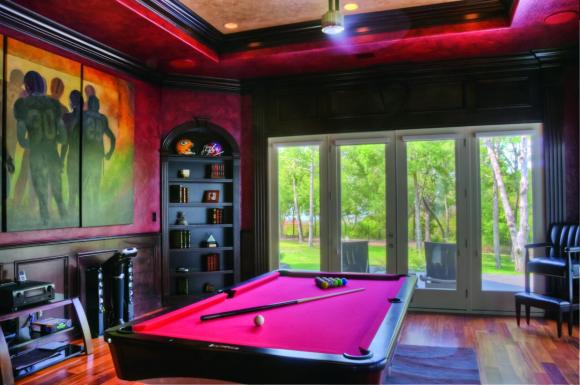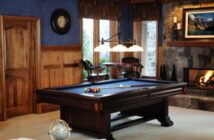Ever dreamt of having a revolving bookcase, a sofa with an escape slide into secret crypt, a fake fireplace that leads to a cellar, or just an excuse to shout “to the Batmobile!”?
Or maybe you find yourself retreating to the garage or shed on a regular basis for a bit of ‘me time’ but just can’t seem to get the privacy you want. Well you could have a man space that is so hidden, nobody knows about it.
I know, I know, they seem like a wacky idea, but come on, imagine how cool it must feel to pull down a book and watch the bookcase revolve as you step into your own secret room which has in it, well, anything really. Some guys are using theirs to house their home theatres and workshops, whereas for others it’s just a novel way of getting to the other side of the house.
So, for all you wannabe Goldfingers and Blofelds out there, there is an answer. Creative Home Engineering is a company based in the US that specialises in manufacturing and installing secret passageways, however, the company’s president and founder Steven Humble says the hideaways are not just a great way of impressing (or scaring) your mates; they can actually serve a very practical purpose as well.

“Peoples’ motives have changed over the years. When I started the company, around 65% of the clients were doing it for fun and to make their house stand out,” Steven says.
“But lately, there has been a shift towards a much more security-orientated reasoning. We have been doing a lot of projects for very high profile clients and celebrities – some want a panic room to protect their family and some need a safe area so that if somebody was to get in, they wouldn’t be able to find their valuables.
“After all, what price can you put on the peace of mind of knowing that your loved ones are safe if somebody was to break into the house? That’s worth more than money. It’s definitely important for anybody who has a security concern.”
Steven adds that a secret passageway can even add resale value to your home, or at the very least provide a memorable feature for prospective buyers.
“When families are looking at houses, yours is going to be the only one with a secret passageway and when they see it, the kids go beserk!”
Well, maybe not just the kids…Come on, be honest, we all would.
He adds, “I think it even changes the way people think about their house. It turns the home into a place that is fun and exciting to live in instead of just a shelter to stop you getting rained on.”
When it comes to ways of disguising your secret tomb, the options don’t stop at the classic bookcase, the only limit is your imagination.
“We do more bookcase secret passageways than any other style because they’re traditional, versatile and fit in almost any house, but we also do a lot of different kinds of wall panelling – stone walls that allow you to push a particular brick to gain entry, various wardrobes with false backs and some full length mirrors. It seems like we’re doing something new every day.”
Steven notes that there are no two projects the same, as every installation is tailored exactly to what the client wants.
“All the projects work differently depending on the level of security. The higher security ones are usually activated by some sort of code or a biometric access control device like an iris or fingerprint scanner hidden in a false compartment. The doors also often have a solid steel vault door on the backside with big interlocking shear pins that retract when the correct code is entered.”

However, if all you want is to trick your mates or hide from the in-laws, the lower security models free you up to have more fun with the door switch. It can be opened in all sorts of crazy ways: there’s the classic book switch, or you could move the chess pieces on a board to a particular position, play certain keys on a piano, or move the hands of a clock to a designated time.
“One of the fun things for us is when a client has a unique idea for how they want their secret passageway to be activated and we get to turn that into a reality,” Steven says.
If you’re like me, one of the first things you’re going to find yourself wondering after you see a bookcase magically swivel round is how it did it.
Well, Steven says that there are some specific trade secrets about how the doorways work that he won’t give away, but he reveals that the book switches are completely wireless.
“There’s a sensor inside the book so when it is tilted, the sensor sends a coded signal to a receiver, which causes the door to release.”
Simple, right?
Well, not quite, but then again, Steven had some significant education and work experience under his belt before diving into his current forte. After studying mechanical engineering at college, he specialised in aerospace engineering and worked with military turbine engines for helicopters and jets in the Air Force.
However, it wasn’t until 2003, when he was working in robotics for a surgical laser company, that he came up with the idea of the secret passageway.

“I had a fairly big house and it had some extra rooms that we weren’t using, so I thought it would be fun to have a secret passage and conceal one of the rooms. It wasn’t for any purpose really, it was just for fun, but I was really surprised that there were no other companies out there creating them.
“I assumed that I wasn’t the only person in the world eccentric enough to want one of these in the home, so I did some research to see if there was a market for my ideas. I found that I got really positive feedback from everyone, so I quit my job, put a couple of secret passageways in my friend’s new home and the rest is history.”
One of Creative Home Engineering’s clients is Phil Schmidt, based in Wyoming, USA. When he found he had a doorway into another room from his pool room, he had an ingenious idea to disguise this adjacent space with an inconspicuous looking pool cue rack.
The key to this passageway’s success is that the design is in keeping with the rest of the room’s theme, so it doesn’t draw any attention to itself, and even if for some reason you did get wind of his passageway, you could stand there all day pulling and twisting pool cues and you still wouldn’t gain access.
Instead, Phil’s doorway opens via a fingerprint scanner that only recognises his and his wife’s fingerprints, hidden in a cupboard above the bar.
“I grew up watching James Bond, and seriously, who doesn’t want to have a fingerprint scanner that opens a secret room? It’s just so cool, everybody should have one,” Phil says.
Just like Steven, Phil mentions that it provides him with not just the wow-factor, but also the security he has always required. He even had some extra reinforcement put into the walls so it now doubles as a panic room.
Once inside, Phil uses the room to house his comprehensive wine collection, and as a place to store and enjoy one of his major passions; coin collecting (he has two high-security safes to keep everything locked away safely).
He also uses it as his own personal space to have some time to himself, mentioning that it is a “great little place to retreat to.”

“It’s a nice place for me to hide away. I have a forty year old table that has been re-covered in copper in there and an old banker’s chair from the 1920s, so I can just sit in my cave, drink some wine, read a magazine, look at some coins and just feel really cool.”
He also adds that if he had to give advice to anybody thinking of installing a secret passageway into their home, they should “do it in a heartbeat.”
“It’s money well spent, it’s unique and it’s a great conversation piece. The use I’ve got from mine, from being a wine cellar, a place for my safes, a secure
area for my family and a little getaway place, has all been well worth it.”
A secret passageway is not for everyone, but one thing is for certain: I’ll definitely be careful around anybody with a suspicious looking bookcase from now on. Especially with Phil, who showed his true Bond villain side when asked how his friends react to his secret room: “Well they thought it was great, but after I’ve shown them it, I have to kill them because it’s my secret room!”





